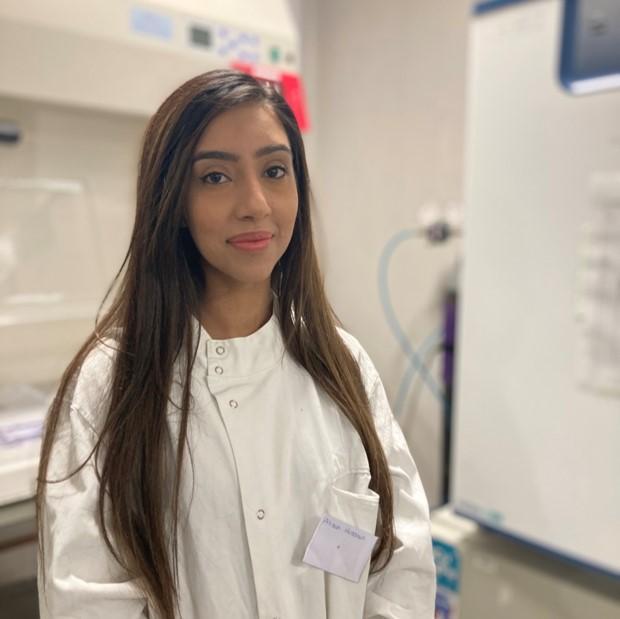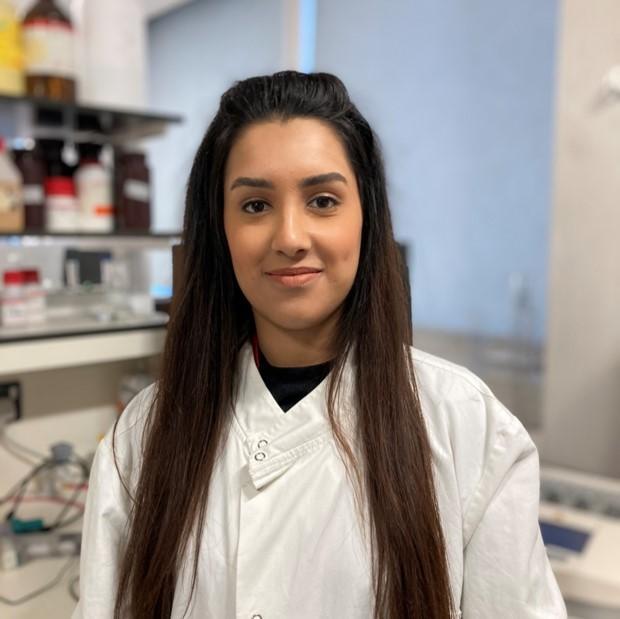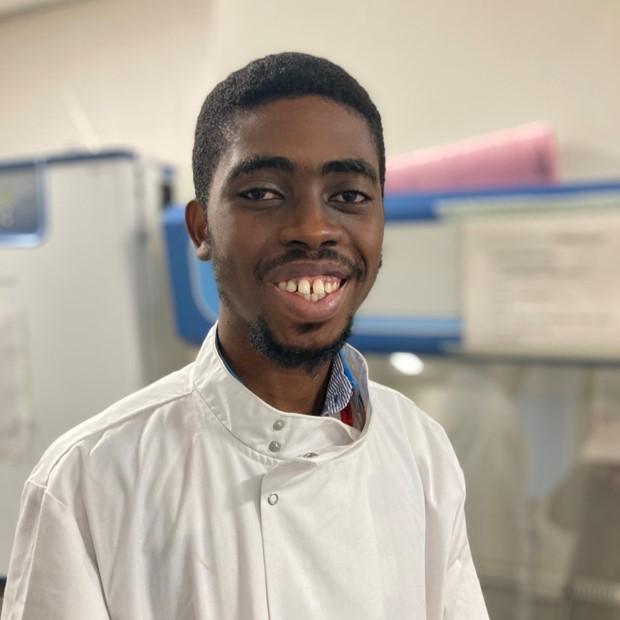PhD students in the Cardiovascular Research Group
Alisah Hussain
Impact of normal and premature ageing on human macro- and microvasculature
The global population is growing and the number of births is consistently higher than the number of deaths. This is because people are living for longer, due at least in part to improved lifestyle and healthcare provision. Consequently, in the UK 18% of the population are aged 65 or above. This equates to almost 12 million people thus factors relating to ageing health are of prime concern. In parallel with the increasing age of the population, we also have an increase in the number of individuals with Type 2 diabetes (T2DM). This presents with features of premature vascular ageing, and currently there are over 4 million patients in the UK alone with this disease, with a further 550,000 patients with T2DM but without a formal diagnosis. Blood vessel issues are common to both ageing and T2DM. These complications include the large blood vessels (macrovasculature), for example the development of atherosclerosis, and the smaller vessels (microvasculature) that can lead to issues such as poor wound healing. Smooth muscle cells (SMC) are the principal cell type in the vascular wall and are responsible for ordered contraction and relaxation, maintenance of vascular tone, and plasticity in cases of injury or disease. This project will examine the molecular mechanisms leading to both physiological and premature ageing phenotypes (using T2DM as a model) in vascular SMC from patients. It will compare and contrast how these mechanisms function across different macro- and microvascular beds.
Supervisors: Dr Kirsten Riches-Suman and Prof Julie Thornton

Ayesha Hussain
Understanding skin ageing in a vascularised human skin equivalent model
The skin is combined of various layers, the epidermis, the dermis followed by the hypodermis. Each layer has a distinctive role that contributes to the functioning of the skin. A skin equivalent model has the potential to show the dermis and epidermis to investigate the anatomy, disorders and ageing of the skin. The production of skin equivalent models is increasing in demand as there has been an increase in the concerns of animal welfare over the past years. Isolating and seeding human dermal fibroblasts and keratinocytes onto dermal/ epidermal constructs that are bioengineered have widespread applications, however the full extent of their use is limited by the exclusion of physiologically relevant structures such as blood vessels. Electrospinning is a bioengineering technique to produce scaffolds made up of polymer and solvent. In this project, electrospinning will be used to generate and evaluate constructs that can support vascular cells, which can then be embedded within the skin equivalents to advance the development of this useful preclinical model.
Dr David Ansell, Dr Farshid Sefat, Dr Kirsten Riches-Suman

Hera Khan
Repression of Angiogenic Markers using Nanoparticle loaded miRNA Mimics
I am a Commonwealth split site Research fellow working on my PhD Project titled “Repression of Angiogenic Markers using Nanoparticle loaded miRNA Mimics”. The research is funded by Commonwealth Scholarship Commission for a period of 12 months. The project deals with using nanoparticles as delivery agents that can cargo tumor suppressor miRNA mimics inside the cell. The miRNA will then inhibit angiogenesis by degrading VEGFa: a major angiogenic marker.
Supervisors: Prof. Dr Anne Graham, Dr Jacobo Elies, Dr Kirsten Suman-Riches

Yaw Asare-Amankwah
Impact of RhoA deregulation on smooth muscle cells phenotypic dysfunction in Type 2 diabetes
Type 2 diabetes (T2DM) is an escalating healthcare burden. The leading cause of death in such patients is the premature development of cardiovascular disease. Patients are more likely to require coronary revascularisation which commonly utilises the autologous saphenous vein (SV) due to its length and availability. SV grafts in T2DM have poor success rates with over 50% failing within 10 years. Smooth muscle cells (SMC) are the major cellular component of the vascular wall. They can switch between a differentiated contractile phenotype (in health) to a dedifferentiated synthetic phenotype in cases of disease or injury, for example following SV bypass grafting. We have previously shown that T2DM-SVSMCs exhibit a unique phenotype that presents with a mixture of contractile and synthetic features, which may impact on graft success. RhoA is a small GTPase that is involved in regulating diverse cellular functions including morphology, migration and SMC marker gene expression. RhoA activity is inhibited in T2DM-SVSMC through a hitherto unknown mechanisms (Riches et al, 2014). Potential routes for deregulation include targeted degradation of RhoA messenger RNA by microRNAs (miRs) or destabilisation of RhoA protein via interaction with Rho guanine dissociation inhibitors (RhoGDIs), Rho GTPase activating proteins (RhoGAPs) and Rho guanine exchange factors (RhoGEFs). It is likely that a fine balance of RhoA regulators may define the final cellular phenotype. This project will determine which aspects of the T2DM-SVSMC phenotype are driven by RhoA deregulation, and examine which signalling pathways upstream of RhoA contribute towards its inhibition.
Supervisors: Dr Kirsten Riches-Suman and Prof Anne Graham

